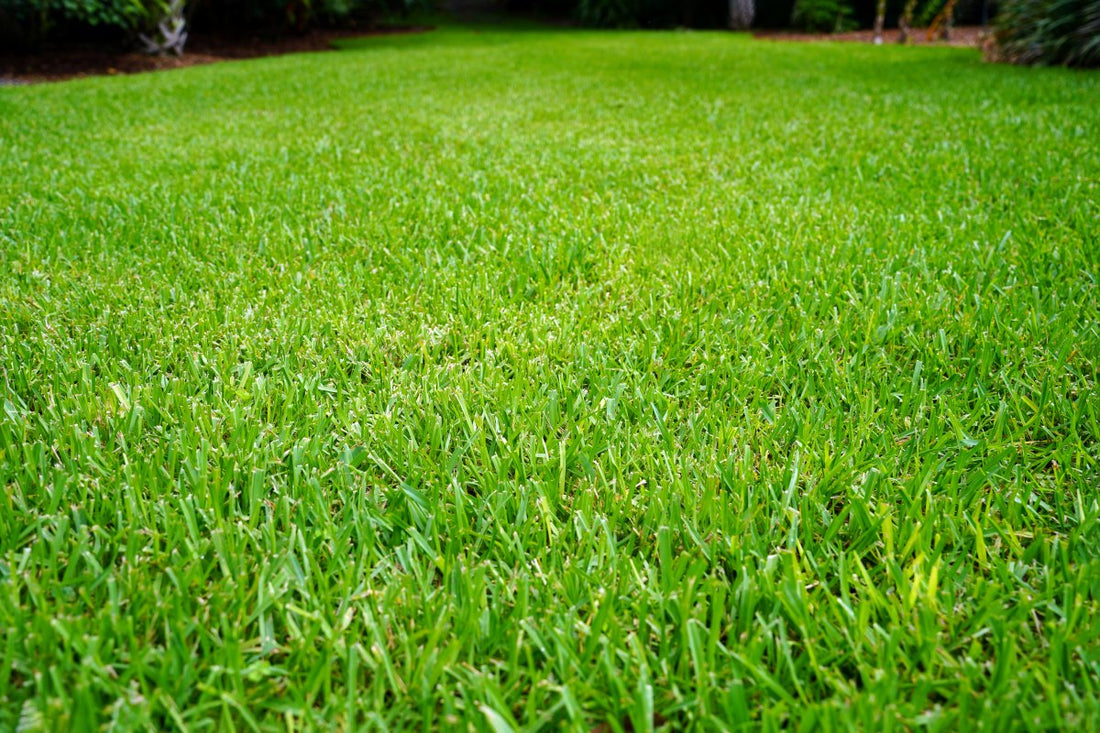A lush, durable lawn begins with choosing the right variety of grass. For homeowners in the southern United States, the different types of St. Augustine grass are among the most popular choices.
Known for their dense growth, vibrant blue-green color, and ability to thrive in heat and humidity, these grasses provide a professional-looking lawn without the need for constant intervention.
But not all St. Augustine is the same. Each variety offers unique strengths in shade tolerance, texture, and climate adaptability.
Without further ado, let's cover the most widely used types of grass seed, when to plant them, and how to maintain them for long-term success.
What this article covers:
- Why Choose St. Augustine Grass?
- Popular Types of St. Augustine Grass
- How to Choose the Right St. Augustine Variety
- Planting and Maintaining St. Augustine Grass
- Frequently Asked Questions About St. Augustine Grass Varieties
Why Choose St. Augustine Grass?
St. Augustine grass has earned its reputation as a go-to warm-season turf for homeowners across Florida, Texas, the Gulf Coast, and other southern regions. Its thick, carpet-like growth quickly crowds out weeds, creating an attractive and functional lawn.
Key benefits include:
- Dense coverage: St. Augustine spreads aggressively through stolons, filling bare spots over time.
- Color and texture: Its signature blue-green hue and broad blades give lawns a rich, tropical appearance.
- Shade tolerance: Compared with other warm-season grasses like Bermuda, St. Augustine performs better in partial shade.
- Heat resistance: Excellent performance in hot, humid conditions common in southern states.
However, it does come with some limitations:
- Moderate drought tolerance: St. Augustine prefers consistent moisture and can struggle in extended dry periods.
- Pest and disease susceptibility: Issues like chinch bugs and brown patch disease are common, requiring proactive care.
- Limited seed availability: St. Augustine is rarely established by seed, making sod or plugs the standard method.
Even with these challenges, the grass remains one of the most popular choices for residential lawns, especially in coastal climates.

Popular Types of St. Augustine Grass
Each variety of St. Augustine grass offers distinct traits. Selecting the right one for your lawn depends on your climate, soil, and the conditions of your property.
Floratam
Floratam is the most widely planted St. Augustine variety in the United States. Developed in Florida and Texas, it was bred for resistance to the St. Augustine Decline (SAD) virus.
It is ideal for homeowners seeking a tough, sun-loving lawn that thrives in the hottest parts of the South.
- Color and texture: Coarse texture with medium-green color
- Strengths: Excellent heat tolerance, high drought resistance compared with other St. Augustine varieties
- Best for: Full sun lawns in hot southern climates
- Limitations: Poor shade tolerance, requiring 6–8 hours of direct sunlight daily
Palmetto
Palmetto has grown in popularity because it offers better performance in mixed conditions than Floratam.
Homeowners balancing sun and shade often prefer Palmetto because it maintains color and density in diverse conditions.
- Color and texture: Finer blades with a softer feel underfoot
- Strengths: Good shade tolerance, vibrant color, improved cold tolerance
- Best for: Lawns with partial shade or variable sun exposure
- Limitations: Slightly more prone to disease than Floratam if overwatered
Raleigh
Raleigh is the cold-tolerant option for homeowners at the northern edge of the warm-season zone.
It's a practical choice for transition areas where warm-season grass is still viable but occasional frost is expected.
- Color and texture: Medium-green with coarse blades
- Strengths: Withstands lower temperatures better than most other varieties
- Best for: Areas in North Carolina, Georgia, or northern Texas where winters dip colder
- Limitations: Performs best in fertile, well-drained soils and may show chlorosis (yellowing) in poor soils

Seville
Seville is a semi-dwarf variety with a reputation for its deep green color and compact growth. It appeals to homeowners who prioritize appearance and don't mind giving their lawn a bit more attention.
- Color and texture: Dark green, fine texture, lower-growing
- Strengths: Good shade performance, attractive appearance, minimal thatch buildup
- Best for: High-visibility lawns where aesthetics matter
- Limitations: Requires attentive care with watering and fertilization, less tolerant of poor soils
Delmar And Sapphire
Both Delmar and Sapphire are specialty dwarf varieties. While these varieties are less common, they are excellent for homeowners who want standout turf with premium aesthetics.
- Delmar: Known for its shade tolerance and compact growth
- Sapphire: Recognized for its striking blue-green color and rapid establishment
- Strengths: High curb appeal and unique appearance
- Best for: Showcase lawns or areas where looks are the top priority
- Limitations: Require more frequent maintenance and care
How to Choose the Right St. Augustine Variety
The different types of St. Augustine grass are designed to perform under specific conditions. Matching your choice to your property's needs is the key to long-term success.
- Climate: Hot coastal regions benefit most from Floratam or Palmetto, while northern parts of the warm-season zone often prefer Raleigh for its cold tolerance.
- Shade levels: If your lawn has moderate shade, Palmetto, Seville, or Delmar are stronger candidates than Floratam.
- Soil type: A soil test kit provides clarity on pH and nutrients before planting. In our work, we've seen time and again that lawns fail not because of the grass itself, but because soil conditions were never addressed. Correcting that first makes every variety perform better.
- Traffic and use: For high-use areas, tougher varieties like Floratam hold up better under wear. For ornamental lawns, Seville or Sapphire offer superior appearance.
A simple decision checklist – climate, sun/shade, soil condition, and lawn use – can help avoid costly mistakes.
Our recommendations are rooted in three decades of caring for properties that demanded nothing less than perfection. That experience taught us that the “best” variety is never universal. It's the one matched carefully to the environment it will grow in.

Planting and Maintaining St. Augustine Grass
Unlike cool-season grasses such as tall fescues, St. Augustine is rarely planted by seed. Sod and plugs are the most common establishment methods.
Once planted, proper maintenance ensures the grass thrives for years.
Establishment Methods
Homeowners need to choose an establishment method that matches their budget, timeline, and property size.
For St. Augustine grass, sod and plugs are the most common approaches, while seed plays a bigger role in other warm- and cool-season grasses.
- Sod: Provides instant coverage and is the most reliable method.
- Plugs: Less expensive than sod, but slower to fill in. Best for patient homeowners who want to save on upfront costs.
- Seed: St. Augustine grass seed is not typically available, so overseeding with it is rarely an option. However, for other species, grass seed remains one of the best tools for establishing or improving a lawn. Homeowners in the South will often pair St. Augustine sod with seed-based overseeding of complementary varieties in transition areas.
Watering Needs
St. Augustine requires consistent watering during establishment.
For sod, water daily for the first two weeks, tapering to two or three times a week until roots establish. Long-term, water deeply and infrequently to encourage deep root growth.
Knowing when to seed lawn matters for other grass types, but with St. Augustine, watering discipline is the key to success.

Fertilization Schedule
Nutrient support is critical. Start with a balanced fertilizer such as Starter 15-20-10 during establishment.
Over time, apply seasonally appropriate fertilizers from our lawn fertilizer collection to maintain color, density, and resilience.
Our professional-grade blends are formulated to deliver measurable results. After three decades of managing estate lawns, we've refined fertilization programs that give DIY homeowners the same level of quality once reserved for exclusive properties.
Pest And Disease Management
St. Augustine lawns face a handful of recurring challenges that homeowners should be prepared for.
The most common problems include chinch bugs, gray leaf spot, brown patch disease, and take-all root rot. Left unchecked, any of these can thin turf quickly and create bare patches that weeds exploit.
The best defense is prevention. Consistent mowing at the right height and balanced watering habits reduce stress on the lawn, while attentive monitoring helps you spot trouble early.
We've seen that lawns treated proactively almost always stay healthier than those managed reactively. Once pests or disease take hold, recovery is not only slower but more expensive.
Frequently Asked Questions About St. Augustine Grass Varieties
Which Type Of St. Augustine Is Best For Shade?
Palmetto, Seville, and Delmar outperform Floratam in shaded areas. Palmetto is often chosen for its balance of shade tolerance and vibrant color, while Seville and Delmar provide finer texture.
In our experience, success in shaded lawns also comes down to proper mowing height and limiting foot traffic so the grass doesn't struggle.
What's The Most Drought-Tolerant Variety?
Floratam has the best drought resistance among St. Augustine grasses, though it still benefits from consistent watering.
Compared with other warm-season types of grass seed like Bermuda or Bahia, Floratam stands out for holding color longer in dry spells. That said, deep, infrequent watering is key to training its roots to perform under stress.
Is There A Low-Maintenance St. Augustine Option?
Palmetto and Raleigh are more forgiving for average homeowners, but all varieties require regular mowing, watering, and fertilization to maintain a healthy appearance.
Palmetto adapts well to partial shade and variable conditions, while Raleigh is reliable in cooler areas of the warm-season zone. Choosing wisely for your region reduces inputs over time, which is the closest thing to “low maintenance” you'll find.
How Long Does It Take For St. Augustine To Establish?
Sod typically takes two to four weeks to root in with proper watering and care. Plugs may take a full season to fill in, depending on spacing and soil conditions.
Conclusion
Choosing among the different types of St. Augustine grass is about matching the variety to your climate, soil, and lifestyle.
From Floratam's heat resistance to Seville's rich green color and compact growth, each option offers unique strengths.
With Lawn Synergy's professional-grade fertilizers, expert timing support, and estate-care experience, you can establish and maintain a St. Augustine lawn that looks like it belongs on a private estate.
For homeowners in across the U.S., we're here to provide not only the right products but also the expert guidance to use them effectively.
Ready to learn more about lawn care? Check out these articles:

